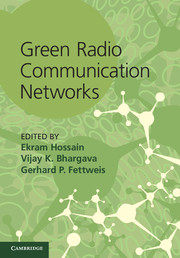Book contents
- Frontmatter
- Contents
- List of contributors
- Preface
- Part I Communication architectures and models for green radio networks
- 1 Fundamental trade-offs on the design of green radio networks
- 2 Algorithms for energy-harvesting wireless networks
- 3 PHY and MAC layer optimization for energy-harvesting wireless networks
- 4 Mechanical relaying techniques in cellular wireless networks
- Part II Physical communications techniques for green radio networks
- Part III Base station power-management techniques for green radio networks
- Part IV Wireless access techniques for green radio networks
- Part V Green radio test-bed, experimental results, and standardization activities
- Index
- References
4 - Mechanical relaying techniques in cellular wireless networks
from Part I - Communication architectures and models for green radio networks
Published online by Cambridge University Press: 05 August 2012
- Frontmatter
- Contents
- List of contributors
- Preface
- Part I Communication architectures and models for green radio networks
- 1 Fundamental trade-offs on the design of green radio networks
- 2 Algorithms for energy-harvesting wireless networks
- 3 PHY and MAC layer optimization for energy-harvesting wireless networks
- 4 Mechanical relaying techniques in cellular wireless networks
- Part II Physical communications techniques for green radio networks
- Part III Base station power-management techniques for green radio networks
- Part IV Wireless access techniques for green radio networks
- Part V Green radio test-bed, experimental results, and standardization activities
- Index
- References
Summary
Introduction
The tendency to devise more sophisticated network-management solutions is expected to sharpen in the near future due to the need to reduce energy-consumption levels of large-scale deployed cellular networks. With the adoption of smart phones that enable full access to different internet applications, mobile users will continue to require more for less. In light of these emerging trends in the use of mobile phones, network operators need to increase network capacity to fulfil the demand, while at the same time keeping capital and operational expenditure low to maintain a competitive edge. Traditional approaches to provide energy efficiency focus on the different elements of the network such as reducing the energy consumption at the component (silicon) level. But it is becoming increasingly apparent that energy consumption should be considered as an architectural element in the design of the network. This more holistic (architectural) view calls for a system-level approach on issues related to energy consumption for the sustainable proliferation of emerging and future wireless networks.
In this chapter, we detail a relaying technique that can be used in general heterogenous wireless access network scenarios whereby mobile relay nodes are allowed to store information while on the move before they engage in transmission with another node or the base station (BS) at a later time instance. This is in fact the fundamental principle of communication in delay-tolerant networks (DTNs), where the silent assumption is that there is no end-to-end path between the source and destination nodes, either due to the sparsity of the communicating nodes or other communication constraints imposed by the specific nature of the network.
Information
- Type
- Chapter
- Information
- Green Radio Communication Networks , pp. 78 - 96Publisher: Cambridge University PressPrint publication year: 2012
References
Accessibility standard: Unknown
Why this information is here
This section outlines the accessibility features of this content - including support for screen readers, full keyboard navigation and high-contrast display options. This may not be relevant for you.Accessibility Information
- 1
- Cited by
